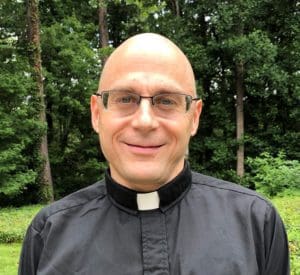How to begin again in prayer
By FATHER BILL NOE, SJ | Published January 7, 2022
The beginning of a new year is a natural time to take a next step, or to begin again, in prayer. There’s something wonderfully hopeful about making a New Year’s resolution. But if you’re like me, you’ve sincerely made resolutions, then soon given them up, perhaps in frustration. Choosing our next step can be challenging.

Father Bill Noe, SJ
St. Ignatius of Loyola was a 16th-century Basque nobleman who became a mystic and teacher of prayer. When he taught, he encouraged people to practice what helped them in their relationship with God and to let the rest go. He believed in each one’s capacity to receive God, and he trusted God to meet each one personally. In faithfulness to his way, I offer these few suggestions, not as an expert, but as a companion on the journey. Considering how much there is to learn, we’re all just beginning!
Here, then, is my first recommendation: Avoid perfectionism! Nothing could more effectively undermine our sincere desire to pray. “Two steps forward, one step back” is a common experience. Sometimes it’s “two steps forward, two steps back,” or even “two steps forward, three steps back!” A sense of humor is a great help here. Even a backward step is an opportunity for intimacy with God. We’re invited to take a long view of the slow process of growth.
Ignatius compared prayer to physical exercise. If we were to go straight for the heavy weights on our first return to the gym, we’d probably hurt ourselves. But how many of us suffer spiritual strains or sprains because of an overly ambitious regimen of spiritual exercise? Thus, my second recommendation: Start small, with something you can do. As we follow through on our intention, we gain confidence and find encouragement. Before we know it, a habit of prayer may begin to form in us. We may soon find that we’re ready for more.
So, practically, what can we do? The possibilities are literally endless. Anything we do in conscious relationship with God is prayer. For example, caring for a newborn child, or marveling at the mystery of their unfolding personality, can be a profound contemplation of the Incarnation. God becomes human, like this child in almost every way. Of course, a more formal practice of prayer also helps most people. Here are three possibilities:
Silence. A daily period of silence can help us to listen inwardly to the movements of our heart. As we attend to these movements of spirit, we can become more aware of God’s active presence in our life. Though it can be scary at first, most people find silence helpful, even enjoyable. We may choose to open brief silent pauses during our day.
Imaginative contemplation. Contemplating a gospel story as though we were present, and even taking an active part, can move our heart in ways that thinking alone cannot. By engaging our imagination, God can give us a more intimate, personal knowledge of the mystery of Christ.
Daily gratitude examen. Each night, we may want to ask God to show us three blessings from the day. Recalling each one in as much detail as we can, we give thanks for the blessing itself and for all the people who brought it to us.
There are so many possibilities! You may want to make a retreat; enter into spiritual direction, or learn about discernment of spirits. Retreat houses can help. Whatever step you choose, I encourage you to be curious about it and to make it in anticipation of discovering something good.
Father Bill Noe, SJ, is a retreat director at Ignatius House Jesuit Retreat Center in Sandy Springs.